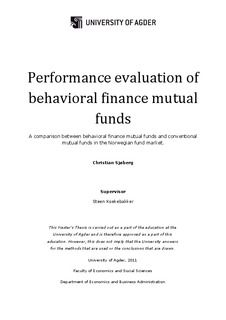| dc.description.abstract | Behavioral finance has been gathering more and more attention in the last decade, and both
academia and practitioners have slowly starting to accept that psychology influence financial
markets. Even though markets are irrational, old theories like CAPM, fundamental analysis
and modern portfolio theory is still widely used. Given the amount of research regarding
behavioral finance, is it impossible to give a complete summary of the entire field, hence, this
study presents a brief review of the most relevant theories in order to give the reader an
introduction to behavioral finance.
With the increased attention to behavioral finance, mutual funds seems to incorporate
different filters to capture irrational behavioral, and to capitalize on irrational investors. The
objective of this study is to evaluate the performance of “behavioral” mutual funds, and to
compare their performance to index funds and non-behavioral funds. However, none of the
funds in the Norwegian market explicitly admits make investments based on behavioral
finance. The selection of funds is therefore based on a detailed and comprehensive review of
67 prospectuses of Norwegian funds, published on the Morningstar and the fund manager’s
website, is done in order to familiarize behavioral mutual funds in the Norwegian market.
Empirical analysis is further applied, where a test for abnormal performance for six mutual
funds identified as behavioral in the Norwegian market is conducted. Further analysis is also
performed in order to recognize the strategy approach of the tested behavioral funds.
The empirical results indicate that behavioral funds are able to outperform index funds and
non-behavioral funds. The results further indicated that behavioral funds are tilted towards
value investing, but fail to earn risk-adjusted abnormal returns. Given the difficulties of
identifying behavioral funds in the Norwegian market, it is problematic to draw any strong
conclusions from this study, but the results indicate that recognizing behavioral inefficiency
may improve the performance of mutual funds.
Keywords: behavioral finance, behavioral mutual funds, market inefficiency, fund performance analysis | en_US |
